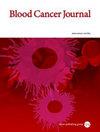EBV+ polymorphic B-cell lymphoproliferative disorder, NOS: a single-center study of a newly recognized pathologic entity.
IF 11.6
1区 医学
Q1 HEMATOLOGY
引用次数: 0
Abstract
EBV-positive polymorphic B-cell lymphoproliferative disorder, NOS (poly B-LPD), is a newly defined entity in the 2022 International Consensus Classification of mature lymphoid neoplasms. Its clinical behavior and optimal treatment approach remain poorly characterized. We conducted a retrospective study of 31 patients diagnosed with EBV+ poly B-LPD at Mayo Clinic (2003-2024), excluding transplant recipients. Median age was 56 years; 71% had extranodal involvement, 68% presented with stage III/IV disease, and 52% had autoimmune conditions. Thirty-five percent (n = 11) were on immunosuppressive therapy at diagnosis, all of whom underwent reduction of immunosuppression (RIS); five underwent RIS alone, achieving four complete responses including two with central nervous system (CNS) involvement. Rituximab was effective in patients with or without prior immunosuppression. Histologic transformation to diffuse large B-cell lymphoma (DLBCL) or emergence of T-cell lymphomas occurred in immunochemotherapy non-responders or at relapse, emphasizing the role of re-biopsy in this subset of patients. At a median follow-up of 6 years, median event-free (EFS) and overall survival (OS) were 8.5 and 8.7 years, respectively. EFS was not significantly influenced by increasing IPI scores (p = 0.09), CNS involvement (p = 0.5), or immunosuppression at diagnosis (p = 0.2). There was a trend towards improved OS in patients who were on immunosuppressive therapy at diagnosis, however, this was not statistically significant, p = 0.054. This is the first study to characterize EBV+ poly B-LPD within the ICC 2022 framework. Larger studies are needed to validate these findings, define prognostic markers and guide therapy.EBV+多形性b细胞淋巴增殖性疾病,NOS:一项新发现的病理实体的单中心研究。
ebv阳性多形性b细胞淋巴增生性疾病(NOS, poly B-LPD)是2022年国际成熟淋巴样肿瘤共识分类中的一个新定义。其临床行为和最佳治疗方法尚不清楚。我们对梅奥诊所(2003-2024)诊断为EBV+ poly B-LPD的31例患者进行了回顾性研究,不包括移植接受者。中位年龄56岁;71%有结外受累,68%表现为III/IV期疾病,52%有自身免疫性疾病。35% (n = 11)在诊断时接受免疫抑制治疗,所有患者都接受了免疫抑制减少(RIS);5例单独接受RIS治疗,4例完全缓解,其中2例中枢神经系统受累。利妥昔单抗对有或没有免疫抑制的患者有效。在免疫化疗无反应或复发时,组织学转变为弥漫性大b细胞淋巴瘤(DLBCL)或出现t细胞淋巴瘤,强调了在这类患者中再次活检的作用。中位随访时间为6年,中位无事件(EFS)和总生存期(OS)分别为8.5年和8.7年。IPI评分升高(p = 0.09)、CNS受累(p = 0.5)或诊断时免疫抑制(p = 0.2)对EFS无显著影响。在诊断时接受免疫抑制治疗的患者有改善OS的趋势,但这没有统计学意义,p = 0.054。这是第一个在ICC 2022框架内表征EBV+ poly B-LPD的研究。需要更大规模的研究来验证这些发现,确定预后标志物并指导治疗。
本文章由计算机程序翻译,如有差异,请以英文原文为准。
求助全文
约1分钟内获得全文
求助全文
来源期刊

Blood Cancer Journal
ONCOLOGY-
CiteScore
16.70
自引率
2.30%
发文量
153
审稿时长
>12 weeks
期刊介绍:
Blood Cancer Journal is dedicated to publishing high-quality articles related to hematologic malignancies and related disorders. The journal welcomes submissions of original research, reviews, guidelines, and letters that are deemed to have a significant impact in the field. While the journal covers a wide range of topics, it particularly focuses on areas such as:
Preclinical studies of new compounds, especially those that provide mechanistic insights
Clinical trials and observations
Reviews related to new drugs and current management of hematologic malignancies
Novel observations related to new mutations, molecular pathways, and tumor genomics
Blood Cancer Journal offers a forum for expedited publication of novel observations regarding new mutations or altered pathways.
 求助内容:
求助内容: 应助结果提醒方式:
应助结果提醒方式:


